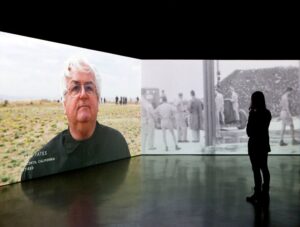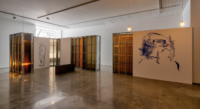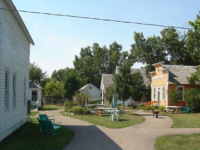U of L professor’s exhibit explores the atomic bomb
By Jensen, Randy on August 7, 2020.
 University of Lethbridge photo - View of Mary Kavanagh's 2-channel video installation, Trinity³, at the Kitchener-Waterloo Art Gallery, 2020.
University of Lethbridge photo - View of Mary Kavanagh's 2-channel video installation, Trinity³, at the Kitchener-Waterloo Art Gallery, 2020.Greg Bobinec
Lethbridge Herald
It’s been 75 years since the birth of the atomic age, and aligning with that is University of Lethbridge professor, Mary Kavanagh, who explores the bomb and its legacies in a series of art exhibitions presented across North America.
The multi-faceted “Daughters of Uranium” and “Trinity3” is a two-channel video work extracted from the larger project. The exhibitions reach across the nuclear Anthropocene to build connections between nuclear technologies and their lived effects, the nuclear site and irradiated bodies, nuclear fallout, waste, and material evidence, the U of L said in a release. The exhibition centres around the Trinity Site in New Mexico where the Manhattan Project took place on July 16, 1945. The purpose of the test was to detonate an atomic device to prove the viability of the bombs that were used in attacks on Hiroshima and Nagasaki three weeks later.
The Trinity Site remains situated on an active military range and is still open to the public during bi-annual open houses that attract thousands of visitors every year. Kavanagh says on her first visit to the site in 2012, she was surprised by the public response to see the site.
“I was not prepared for the thousands of people that came through on this one day,” says Kavanagh. “So that piqued my interest, raised the questions: who are all these people and why do they come? Which then became the essential questions in my applications for funding.”
In addition to receiving grants from the Canada Council for the Arts and the Alberta Foundation for the Arts in 2017, Kavanagh was awarded an Insight Research Creation Grant from the Social Science and Humanities Research Council of Canada (SSHRC). Her project received nearly $150,000 in funding over four years to support fieldwork, mentor graduate students and access the equipment and infrastructure needed to conduct the research.
Graduate student Tyler Muzzin had the privilege of working alongside Kavanagh, travelling to New Mexico and experiencing firsthand the culture of atomic tourism and assisting with interviewing visitors on site.
“The perspective of an artist who works with monolithic bodies of thought, as Mary does, who considers things like phenomenology, ethics, archives, and integrates all this within a history of aesthetics and visual culture is important – and has a potentially huge impact on public perception of significant events and topics,” says Muzzin.
Featured in Kavanagh’s exhibitions is a serial compilation of interviews, presented as moving image portraits, revealing a profound collective anxiety filtered through the specificity of the Trinity Site. The first scholar at the University of Lethbridge to receive a SSHRC Insight Research Creation Grant, Kavanagh’s research straddles the academic and art worlds.
“Interpreting historical, political and cultural dimensions of the nuclear age is a challenge for any artist,” says Kavanagh. “It’s important not to lose sight of an essential, visceral experience and expression while addressing complex issues in material form.”
Recently, Kavanagh was awarded a Board of Governors Research Chair, Tier I in Fine Arts (2020-25), and looks forward to continuing her research program while instructing and mentoring the next generation of artists and scholars.
Follow @GBobinecHerald on Twitter
15-14




